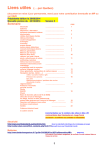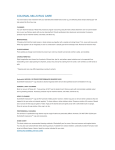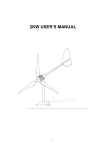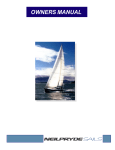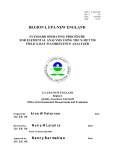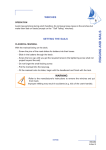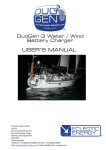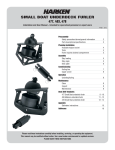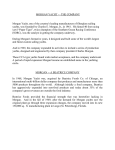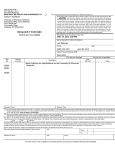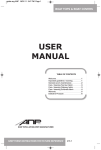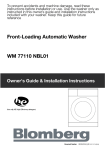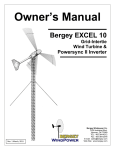Download Luff Tape Conversions & Sacrificial Sun Covers
Transcript
103796*1 Luff Tape Conversions & Sacrificial Sun Covers Luff Tape Conversions & Sacrificial Sun Covers MATERIAL CHOICES Con tinu ous Sup por t Ta pe There are two materials that work well as sun covers. Sunbrella, a solution dyed acrylic, is by far the most common and the most durable selection. It is available in a wide range of colors; however, Sunbrella is relatively heavy at 9.5 ounces per yard. For small boats or areas with light air and moderate sunlight, a 3 oz. UV protected Dacron insignia cloth is the better choice. This material is only available in white, but it is light and very easy to install given its adhesive backing. It is also precut to 18", 14", or 10" wide strips. Both materials will need to be sewn. If the sail is in questionable condition and needs to be replaced in the near future, it may be wise to forgo the sun cover and just install the luff tape. The exposed sailcloth can be protected with a sock that is pulled up on an extra halyard to cover the furled sail. This cover can be used with any new sails. Leech over Luff uff mL Foa Modern reefing/furling units make use of a continuous support tape along the leading edge of the sail that slides into a groove in the furler. When converting a sail to roller furling, the existing luff tape, any wire or rope, and all hanks, grommets, and thimbles must be removed. Simply cut in back of any grommets in the sail (along the inner edge of the luff tape is ideal). This cut must be accurate so that an even width of material is removed from the leading edge of the sail. Sun C PREPARING FOR ROLLERFURLING LP ADJUSTING THE LENGTH OF THE LUFF Check the length of the sail’s luff and the length of the roller furling gear’s extrusion. Most genoas are designed with luffs that stretch nearly the full length of the head stay. When the roller-furling gear is added, the drum and the head swivel shorten the usable stay length and therefore the sail’s luff may need to be shortened. The furling unit manual will give a sailmaker’s luff deduction measurement. This measurement is usually relative to the pin to pin length of the forestay. Deduction Max. Luff Length Stretch Reduction Final Luff Length 12" 6" Round Stainless Ring (attached with 1" tubular webbing) (usually 2% of max. luff) 2. Measure from the new sail head one quarter of the way down the luff. Use a pencil to place a mark in from the sail’s edge (equal 75% of “A”). 29' - Foot (user’s manual) 30' - er Cov 1. Determine how wide the wedge will be at the head of the sail by measuring up from the tack of the sail to the Final Luff Length. Mark the leech edge at this distance. Then measure from here to the forward sail edge. This Cut Off Distance (labeled “A”) should be perpendicular to the luff. EXAMPLE: P-Pin Sun 28'6” If the furling unit manual does not give the luff deduction measurement, then the maximum length that the furling gear will accommodate must be determined by tying the end of a tape measure to the halyard swivel shackle and raising it to its uppermost position. Read the tape at the tack shackle for the maximum luff length. Apply the 2% stretch reduction to determine the final luff length. The luff edge of the genoa is probably slightly hollow near the head and slightly convex near the tack. When cutting a wedge out of the sail to shorten it, the original luff curve needs to be duplicated. 3. Place a mark half way down the luff (equal to 50% of “A”). 4. Place a mark three-quarters of the way down the luff (equal to 25% of “A”). 5. The new and old luff will meet at the tack. After marking these points, connect them with a smooth pencil line and cut off the wedge (Figure 1). It helps to use a long wooden or plastic spline to make the pencil line fair, but a yardstick will work if care is exercised. Shortening the sail this way also raises the height of the clew which tends to make the sail roll more evenly on the luff. Luff Tape Conversions & Sacrificial Sun Covers 2 ADDING A SUN COVER USING SUNBRELLA FABRIC Cut Off Distance (A) If head patch will be cut down 50% or more, move the head patch instead of cutting it too small. First determine how many panels to cut. Sunbrella can be cut along its length but cutting across its width is more efficient (Figure 2). 1/4 Down Luff (.75 A) 46" or 60" Width Width Figure 2 1/2 Down Luff (.5 A) Use the following formulas to determine the number of panels needed: How to Reduce the Luff Length (when necessary) 3/4 Down Luff (.25 A) Use this technique to duplicate old luff curve. Figure 1 THE NEXT STEP—ADDING A SUN COVER The luff of the sail is now ready for installation of the appropriate continuous support tape, however a sun cover should be added first if needed. The cover must be of sufficient width to completely cover the leech and foot edges of the sail when furled. Generally the leech width will be greater than the foot width. This is because the angle at the tack of the sail is almost always greater than at the head. Use the two formulas below to determine panel widths. The formulas require knowledge of the sail’s luff length and LP (length perpendicular). Find those measurement first (see drawing previous page) and then plug them into the formulas. LUFF LENGTH (ft.) / (LP (ft.) /6) = FOOT PANEL WIDTH (in.) To determine the panel width needed to cover the leech of the furled sail: LUFF LENGTH (ft.) / (LP (ft.) /8) = LEECH PANEL WIDTH (in.) The resulting widths are rough guides only, but they are generally wide enough (excess width is not a problem). These panels will be cut from Sunbrella OR from a 3 oz. UV protected Dacron insignia material. Follow the appropriate instructions based upon material selection. For 46” Sunbrella: FOOT LENGTH / 3.75 = # OF FOOT PANELS LEECH LENGTH / 3.75 = # OF LEECH PANELS For 60” Sunbrella: FOOT LENGTH / 4.92 = # OF FOOT PANELS LEECH LENGTH / 4.92 = # OF LEECH PANELS Cut the appropriate number and widths of panels. The short edges of each panel do not require hemming (already heat sealed by the cloth manufacturer). The long (46”) edges can be attached by either creating a 1/2” fold along each 46" side and butting the panel edge up to the edge of the sail and sewing (Figure 3) or if a leech or foot line is involved, the panel can be wrapped over the edge of the sail (Figure 5A). 1/2" Hems Sunbrella long placed a ge leech ed ce fa m e (h il) sa n o n dow Leech Edge e of long edg placed a il) sa n o Sunbrella n face dow foot (hem Foot Edge Figure 3 Before attaching the Sunbrella panels to the sail, verify which direction the sail is to furl. If the drum furls clockwise, sew the Sunbrella on the port side of the sail. If the drum furls counterclockwise, sew the Sunbrella on the starboard side. Use pins, a long arm stapler, basting tape, or a combination of all three to secure the Sunbrella panels in place. 3M Super 77 spray adhesive also works well for this application (spray the panels one at a time, away from the surface of the sail). Carefully baste the panels so they are flat on the sail and not under any stress which leads to leech flutter. Use plenty of pins, staples, or basting tape as the stretch in Sunbrella makes it difficult to keep flat. Luff Tape Conversions & Sacrificial Sun Covers HOW TO AVOID YOUR LEECH LINE If the sail has a leech and/or foot line, one long edge of 3 1 1" Fold Over Sail Edge 2 Sew straight stitch along inner edge of acrylic at sail edge Leech or Foot Edge each cover panel rectangle should not be hemmed. This edge will be used along the outer edge or edges of the sail and should be wrapped around that edge and sewn in place. Using this technique, the cover will not interfere with the leech or foot lines (Figure 5A). It is best to use a hot knife to seal the unhemmed Sunbrella acrylic edges. Leech/foot line free in hem or tape Leech or Foot Edge Figure 5A Push line toward sail’s center as you sew along edge OR Follow the original steps, but instead of wrapping the acrylic Straight Stitch around the sail’s edge to avoid the leechline, make it flush with the edge (as done with sails without leech lines). Be careful to push the leech line in toward the sail’s center as you sew the acrylic cover down (Figure 6A). As long as the leech or foot line is free to move inside the edge of the sail this process will not cause any problems. Figure 6A (Cross-Section View) Continue to lay the Sunbrella panels along the edge of the sail with a 1/2" overlapping each panel. If the leech or foot is sharply curved, angle each panel so that it follows the sail’s shape (Figure 4). Fold the hem along the sail edge after basting the panels in place so an accurate match can be maintained. If the machine balks in the tack and clew areas, sew by hand with a sailmaker’s needle and a length of waxed sail. Use a simple flat stitch (penetrate the material, move forward about 1/4", penetrate it from the other side, and continue). Trim the Sunbrella away from the rings at the head and tack. Leave enough to create a 1/2" piece to turn under for a hem. Sew these hems down (Figure 6). Panels angled so that they follow the sail's shape Figure 4 After all panels are in place, sew them to the sail using straight or zigzag stitches. Start with the leech and foot edges and then sew the inside hemmed edges followed by each of the short overlapping panel edges. Finish by sewing a diagonal across each panel (Figure 5). Cut the UV cover cloth around corner ring Figure 6 Now, if the Sunbrella has been put on the “right” (as opposed to the “wrong” side of the sail, it will automatically provide a cover when the sail is furled. ADDING A SUN COVER USING DACRON INSIGNIA MATERIAL Figure 5 A 3 oz. UV impregnated Dacron insignia material can also be used for a light weight rollerfurling cover. It comes precut in 10", 14", and 18" wide adhesive-backed strips (review formulas for determining appropriate panel width). If the insignia material is a few inches too wide, do not bother cutting it down as extra width is not a problem. Luff Tape Conversions & Sacrificial Sun Covers 4 In most cases, 3 panels are used along the foot and leech (Figure 7). Divide the sail’s leech and foot measurements by 3 and cut each panel to those lengths plus about 3 inches extra. Sew the adhered panels to the sail using a zigzag stitch placed within 1/4" of the panel’s edge. Sew along the inner edge, across the short overlapping panel edges, along the outer edges of the foot and leech (Figure 9), and in a diagonal pattern across each panel (Figure 5). If sail has leech or foot line sewn behind it, leave enough room for movement UV Insignia Panels Zigzag Stitch Leech Luff Leech Foot Figure 9 CONTINUOUS SUPPORT TAPE INSTALLATION Foot Figure 7 Position the panels so they can be folded around the foot and leech edges. Overlap the edges of the sail by at least 1 to 1-1/2" (Figure 8), and overlap the ends of the separate panels by approximately 1/2". Angle the panels to follow the sail’s shape. This support tape does not need to be stretched as it is attached. The sail is supported all along its length so a lack of tension along the luff will not cause scalloping. (See our Choosing Support Tape for Headstay Systems chart online for matching headstay systems and continuous support tapes.) Fold UV cloth 1" over sail edge to form hem Ins ign ia P ane l Le e ch Cut the support tape a little longer than the new luff length. Open it up and sandwich the luff of the sail inside. Let some of the tape extend beyond the head and the tack. Use staples to hold the tape in place or apply an acrylic basting tape between the support tape and the sail on each side. Keep the tape wrinklefree and do not stretch the tape or the sail during application. UV A small slit will help make hems lie flat when folding over. Sew continuous support tape along the leading edge of the sail. These pre-finished tapes are made up of two (three in a one Hood system) small, hard, braided cords that are sewn into a narrow fold of Dacron cloth. The size of the braided cords and their spacing is very important to the proper working of the roller furling system. For that reason, continuous support tapes are usually purchased pre-finished and then simply attached to the sail. Patches Sew the support tape in place with two rows of zigzag stitches, the first row as close to the secondary cord as possible and the second row along the inner edge of the tape (Figure 10). Figure 8 Next peal the paper backing away starting at the corner of a panel and smooth the material down as the backing is removed. When all panels are in place, trim the narrow strip that overlaps the edge of the sail so that it is a consistent width (3/4 to 1" all along its length). Fold this strip over against the other side of the sail. Sail Figure 10 Luff Tape Conversions & Sacrificial Sun Covers 5 ATTACHING STAINLESS STEEL RINGS AT THE HEAD AND TACK Use webbing and follow the 6 steps to attach a ring at both the head and tack sail corners. 1 Trim the support tape at the head of the sail. 4 ring Sew the webbing in place with two rows of zigzag stitches along each length of webbing. 3" Cut along dashed line 2 Trim the support tape at the tack of the sail. 5 Cut along dashed line 8" Use a #16 sailmaker’s needle and waxed, double-strand of 4-5 ply sail twine to fasten the ring firmly in the loop. Pass the needle through the webbing as close to the ring as possible. Bring the needle through the ring and move 3/8" along the ring and repeat. Proceed until the entire base of the ring is firmly fixed in position. ring 3 Place the head ring in position and secure by placing in loops of webbing. The width of webbing is not critical but should extend into the sail about 10 inches. 6 10" Use the same procedure to fasten the tack ring firmly in its 3 webbing loops. Optional third strap bisecting first two Luff Tape Conversions & Sacrificial Sun Covers 6 ADDENDUM Con tinu ous Sup por t Ta pe ADDING A FOAM LUFF A pad of PVC closed cell foam with a Dacron sailcloth surface is sometimes installed along the leading edge of a furling sail to help flatten the sail as it is furled. The foam is wider toward the center of the sail to create more bulk in the center and help flatten the sail as each additional wrap is taken. It also maintains the sail’s designed draft. Cover the exposed surface of the foam with a 3 oz. UV impregnated Dacron insignia material. Wrap the insignia material around to the back side of the foam tape to protect the foam edges and for a neater appearance. over Sun C Cut the foam tape to its proper shape by finding the LP point in the sail (the LP line is perpendicular to the luff and intersects the clew). Measure 5% of the total luff length at each side of the LP and make pencil marks on the foam. The distance between these marks is the full width. Boats under 25 feet should use a maximum width of 9". Boats from 26 to 35 feet should use 11" tape. Larger boats can use 12" tape (full width of the material). From these marks, trim the foam tape down so that it narrows to 2" at both ends. Use a straight edge and pencil to mark a line on the foam before cutting. Leech Luff Foa mL uff Simply cut the foam tape approximately two feet shorter than the length of the sail’s luff. Lay the sail out flat and place the foam tape flush along the luff edge just behind the second braided line in the support tape. The ends of the foam tape should stop at the sail’s head and tack patches. LP Sun er Cov Foot Round Stainless Ring (attached with 1" tubular webbing) Baste or staple the foam tape in place (or use the Super 77 spray adhesive) and sew down using a 1/4" zigzag stitch about 3/16" from the edge of the foam all around the perimeter. NOTE: Oftentimes it is possible to purchase the foam tape in a shorter length (about half the length of the sail’s luff edge) instead of the full length of the luff edge. Since the foam tape is tapered down at its ends, pattern and cut the foam tape out in two pieces (patterning one half above the other) and join the pieces with a butt seam somewhere near the middle of the luff. Sailrite Enterprises, Inc. 2390 East 100 South, Columbia City, IN 46725 Phone (800) 348-2769 / (260) 244-4647 Fax (260) 818-2005 Email [email protected] Sailrite.com © 2015 Sailrite Enterprises, Inc.







